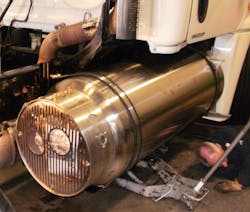An explanation of reman, repower and rebuilt
The terms remanufacturing, rebuilding and repowering are three of the most misunderstood terms in the trucking industry. It is easy to see why there is confusion. Often, the terms are used interchangeably or are used to describe what the other term means.
The trucking industry’s investment into gliders as an alternative to the purchase of a new truck has led to a renewed scrutiny and need to better understand reman, rebuilt and repower sources and suppliers.
Terms Simply Put
- Remanufacturing – This refers to a complete disassembly of engine and powertrain components followed by a reassembly of parts and systems to original equipment specifications. Remanufacturing requires rebuilding from the bottom up according to very stringent guidelines with a very close attention to quality.
Disassembled pieces and parts are:
- Cleaned to remove grease and corrosion, refinished and returned or repainted to their original color.
- Inspected for any areas that are out of spec.
- Reassembled with new nuts, bolts, washers, studs and plugs and bearings.
Any piece showing wear is either repaired or replaced prior to being reassembled, so the end result is “just like new.”
For this reason, a remanufactured system is often covered by warranties that are similar to original new equipment.
- Rebuilding – This commonly refers to operational repairs and replacement parts to extend the vehicle’s useful life. Parts that are still functional are cleaned and reused. Those that show wear or are broken are replaced.
The overriding goal of a rebuilt system is as a stop-gap to keep the vehicle operating. The net result is not necessarily a system that will meet emissions control mandates or original equipment standards.
A rebuilt engine or powertrain component would be less likely to be covered by warranty.
- Repowering – This typically refers to replacing one engine or component for another make or model in a vehicle. In trucking today, repowering also may refer to upfitting a vehicle for use of alternative fuels, such as installing the dual fuel natural gas conversion technology.
It also may refer to a complete changeover from one fuel system to another. For instance, the United States Postal Service recently committed to repower vehicles from gasoline to diesel in order to achieve fuel economy gains and a lower cost of ownership.
How to Choose
In comparing and selecting a supply partner for remanufactured, rebuilt or repowered components, it is important to choose a reputable supplier that has experience in the field and is willing to stand by its work. In making your decision, it is critical to ask questions and understand what is, or is not, included in the component’s performance as well as purchase. Understanding if warranty coverage is local, regional or national is also important.
Gliders
Truck gliders are an affordable option that gives older powertrains or drivelines new life. Although the option has been around a long time, interest in them increased considerably during the last recession as fleets and owner operators looked for viable and affordable ways to extend the life their equipment.
A glider is often a new truck chassis (with all the amenities) equipped with two of three powertrain or driveline components that have been remanufactured or rebuilt. Gliders today offer truck owners all the power and familiarity of trusted componentry with lower upfront cost, potentially lower maintenance costs and improved resale value.
New technologies, like dual fuel natural gas conversion technology, can displace a significant percentage of the normal diesel fuel consumption and offer truck owners the chance to take advantage of the benefits of using natural gas to further reduce operating costs, as well as comply with alternative fuel contract award requirements.
A line of new severe duty gliders equipped with dual fuel technology was launched to work under the harshest industry conditions. These include oil and gas production, where the dual fuel technology can be adapted to run off wellhead gas that would otherwise be flared off, as well as mining, logging and over-sized load trucking applications.
Whether components are remanufactured, rebuilt or repowered, the opportunity is here to extend the useful life of older equipment and bring poor-performing equipment into compliance – rather than sending it out to crushers. The key to making the right choice in purchasing or working on the equipment is in understanding its origin, its performance history and what was included prior to and during its installation.
Chris Craddock serves as director of purchasing for the WheelTime Network (www.wheeltime.com), North America’s largest dedicated service and parts network for Quality Truck Care.
